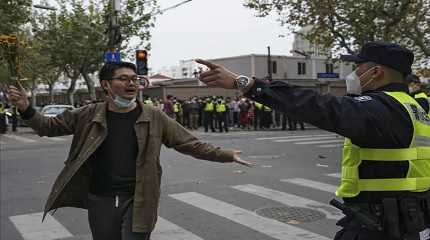
SHANGHAI (AP) — The mourners in Shanghai lit candles and placed flowers. Someone scrawled “Urumqi, 11.24, Rest in Peace” in red on cardboard — referring to the deadly apartment fire in China’s western city of Urumqi that sparked anger over perceptions the country’s strict COVID-19 measures played a role in the disaster.
What started as a small vigil last weekend by fewer than a dozen people grew into a rowdy crowd of hundreds hours later. One woman defiantly shouted for Chinese leader Xi Jinping to resign, emboldening others. Then, before dawn, police swept in and broke up the gathering and prevented more from happening.
The Nov. 26 protest in Shanghai wasn’t the first or the largest. But it was notable for the bold calls for change in China’s leadership — the most public defiance of the ruling Communist Party in decades.
Nationalist bloggers swiftly blamed foreign “black hands,” and the government vowed to crack down on “hostile forces.” But the protest emerged spontaneously, according to 11 participants and witnesses interviewed by The Associated Press. It was the first political demonstration for nearly all of them, and they spoke on condition of not being fully identified for fear of police harassment.
Resistance to the policy had been building for weeks. In central Henan province, workers walked out of an iPhone factory when told they’d be locked in as part of virus controls. In cosmopolitan Guangzhou, residents brawled with police enforcing lockdowns.
Earlier that day, from Chengdu in the south to Harbin in the north, university students confined to campuses for months lit candles, sprayed graffiti and took selfies while holding signs mourning the Urumqi dead.
Road signs on Shanghai’s Urumqi Middle Road were surrounded by candles, signs and flowers. Dozens had gathered by 10:30 p.m., according to friends of participants.
Then patrons spilled out of a nearby bar after a World Cup match between South Korea and Uruguay, according to a friend of an early participant. Many joined the vigil, taking photos and sharing them online.
At 11:21 p.m., a popular Twitter account tracking dissent in China posted images of the vigils, drawing the attention of many who had been scrolling anguished posts on the Urumqi fire.
That the blaze resonated in Shanghai was no coincidence, participants said. Many of the city’s apartment buildings were sealed-off during a lockdown in April and May, sparking fire safety fears and leaving many seething.
“People could not only empathize with the people in Urumqi, they realized that this could also be them,” said Dali Yang, a China expert at the University of Chicago.
A person who identified himself only by his French name Zoel said he attended to pay his respects after seeing a photo on the Chinese messenger app WeChat. When he got there past midnight, he found sizable crowds — and police. People had gathered at two spots, laying flowers and lighting candles.
“It was very peaceful, ” Zoel said.




